Oct 2012
Strange and unsettling seal pup season
Oct/29/12 06:06 AM
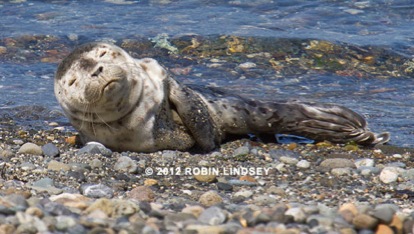
We want to assure people that this does not mean we have a seal pup “death epidemic”. Harbor seal pups only have a 50% chance of surviving their first year. This is due to many factors, including predation and disease. This means, in theory, one out of every two pups that our volunteers watch over can perish. And we do respond each year to numerous dead animals. However, in West Seattle our response mortality rate has just never come close to approaching such a high percentage at this point in the season as our current 44% rate for 2012. But what has been equally unsettling is that so many of our live pups this year have been terribly thin. As we still have two full months remaining in 2012, our total pup deaths will undoubtedly exceed last year’s count, but the mortality percentage will change - hopefully, for the better and not worse. Winter months pose grave difficulties for weaned seal pups. At the end of the year, we will post our final statistical findings.
Harbor seals are considered by biologists to be an indicator species for the health of our waters. Year-round residents, they do not migrate. Harbor seal pups are especially vulnerable to any kind of imbalance in our waters, including contaminants and disease, due to an already weakened immune system. While nursing, a pup has the benefit of partial immunity from mom’s milk. However, once the pup is weaned, there is little protection from emerging diseases. Contaminants, such as flame retardants and storm runoff, pose tremendous risk to seal pups (as well as all living marine organisms - read more on our website) and contribute to virus infection. Additionally, a pup usually drops a fair amount of body weight after being weaned and trying to forage on his own. Opportunistic parasites, such as lungworm, take advantage of this further suppressed immune system, often leading to respiratory disease and pneumonia, a very difficult health challenge for a pup to overcome.
We want to stress that at this juncture we have no idea if there is an underlying link causing these thin pups and deaths, but have been consulting with a prominent marine mammal biologist and inquiring as to statistics from other stranding networks. Perhaps we simply have fewer healthy pups hanging out in West Seattle because there is not a sufficient food source in our area this year. Perhaps if food sources were depleted, moms didn’t nurse the full 4-6 weeks, leading to weaker pups. Or, could there be something else going on?
Research is critical to monitoring the health of harbor seal populations and that of the Sound. Unfortunately, there is inadequate funding for crucial, and relatively expensive, tests. Federal Prescott Funds which support the vital work of NOAA’s nationwide marine mammal stranding networks is on the chopping block to be eliminated from Congress’ 2013 budget. It was not included in the president’s budget proposal. This funding enables networks across the country to respond to stranding and mortality events and perform scientific research into infectious marine mammal diseases, such as brucella and the lethal morbillivirus.
For the past 6 years, Seal Sitters has delivered fresh dead seal pups to WDFW Marine Mammal Investigations Unit for necropsy. Because of this research, several years ago a human virus (reovirus) was isolated in those pups. This meant that our urban seals were coming into contact with human sewage - and probably many other species in the Sound were in contact with sewage as well. Currently, the WDFW biologist is waiting for results on tissue samples from two of our 2012 pups to help determine cause of death. Many emerging diseases are transmitted between species. Recently, research discovered that a parasite known only to land mammals was found in marine mammals. This was apparently due to cat feces reaching marine waters. You don’t have to be a scientist to realize this cross-species infection of disease can be devastating on many levels.
We cannot stress enough that funding for this critical research needs to continue. Please email your congressional representatives, insisting that John H. Prescott Funds be included in the 2013 Federal budget. The health of our seals - and the Salish Sea - affects all of us.
Please remember that all seal pups are struggling to survive. Observe them quietly from a distance.
Be a seal pup on Halloween - great and easy costume idea
Oct/27/12 11:01 AM
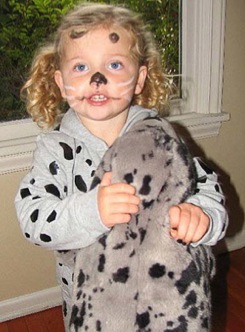
While you’re out trick or treating, you can be an Official Seal Pup Ambassador. Tell people that seal pups need rest to survive - and to never touch or move them and don’t forget to call Seal Sitters. Like you, they need to nap undisturbed so they can grow up big and strong.
Just be sure not to lie down in your costume and take a nap - or you may wake up with yellow tape, cones and volunteers around you!
Email us a photo of you in your seal pup costume and include your first name and age.
Aloha, Ma Kai - seal pup finds safe harbor for 7th night in a row
Oct/26/12 08:53 AM
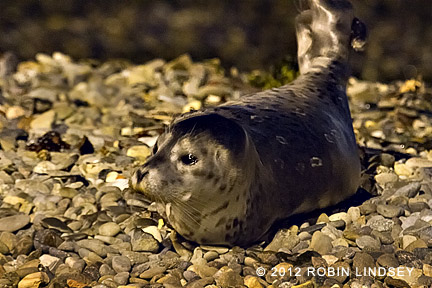
Sixth grade student Kai and his mom first alerted Seal Sitters’ hotline about this pup last Friday night. Since we already had a pup named Kai, this pup was dubbed Ma Kai, meaning “near the sea” in the Hawaiian language.
It is interesting that tides don’t seem to be a factor in Ma Kai’s haulout patterns, which seem to be dictated more by darkness. Does she feel safer on shore with fewer people and dogs? Weaned pups become much more wary of humans and activity as they get older, much like adult seals who are extremely shy of people.
Our responders check periodically throughout the night and early morning on Ma Kai. This pup is vulnerable in an area known for use by people and, too often, off leash dogs - so, our volunteers have been vigilant. Ma Kai returned to the bitter cold Northwest waters before sunrise this morning.
Long days and nights for Seal Sitters protecting pups
Oct/21/12 08:09 AM
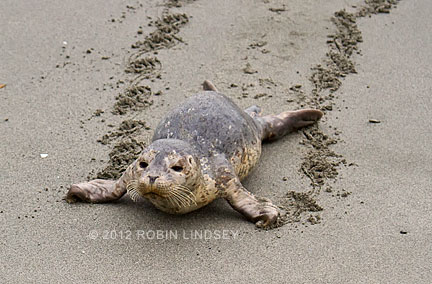
For five nights in a row, a late visitor nicknamed Nocturne, used a stretch of sandy beach to snooze in the relative quiet of darkness. The alert pup was a welcome sight for our volunteers - finally, a chubby pup to watch over, after responding to so many terribly thin pups this season. Each morning before sunrise, our responder has checked the beach but the pup has been gone. Our fear, of course, is the many people who insist on allowing their dogs off leash late at night and in the wee hours of the morning. Or a runner zipping down the beach in the darkness could easily step on a sleeping pup.
On Friday night, the hotline received a call from a young boy and his mom who discovered another pup on a public access cove. Our responders, who were observing Nocturne with volunteers, quickly took off to find the next pup and secured the area with stakes, tape and signs while the pup stretched, yawned and rolled over on her back to take an extended nap. The pup, nicknamed Ma Kai, was checked on periodically throughout the night and returned to Elliott Bay about 5:30 am Saturday morning.
Around 7am Saturday, hotline operator Dave answered an early call with yet another report of a pup on a public beach (photo above). Within minutes, our responder was at the location and the pup was cordoned off. This chubby pup stayed on shore for a couple of hours and then returned to the Sound. As is our practice, volunteers waited about 1/2 hour before taking down the perimeter and left the scene. Shortly after, the phone rang that the pup was back at the same location. Volunteers re-established the yellow tape perimeter. This pup went in and out of the water all afternoon and into the night. By the third time, we were wise enough to leave the tape up, knowing the pup would return. Thanks to all the volunteers who put in long hours on a very strange weather day - including a drenching downpour.
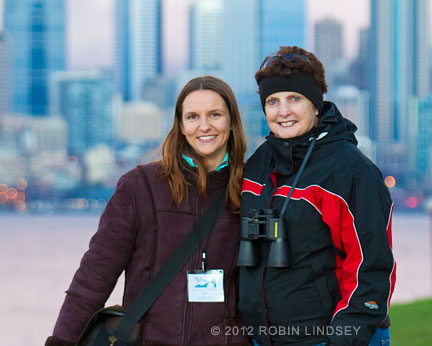
Needless to say, our responders are a tad tired after Nocturne and Ma Kai’s on-going night adventures. Volunteers Nina and Theresa are shown watching over Nocturne at dusk last evening. Ma Kai also returned to her cove last night for another long rest, but was gone at 5am this morning.
10/21/12 12:48pm PUPDATE
Nocturne was not on the beach at 5:15 this morning. However, at 10 am we noticed fresh tracks in the sand, but no pup in sight. We fully expect him to return this afternoon as the tide recedes - the little trickster may well take a sun break on the sand. Or, he could pick another spot just to keep us on our toes. Please call the hotline @ 206-905-7325 (SEAL) if you see a pup on shore.
Rescue of injured seal pup a combined effort of networks
Oct/16/12 08:54 AM
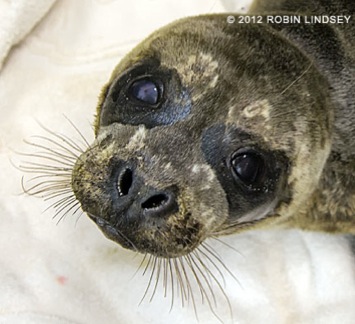
Yesterday, Seal Sitters’ volunteers met up with a volunteer from Vashon to transport an injured seal pup to PAWS in Lynnwood. Four NW marine mammal stranding networks had been on the lookout for the severely lacerated pup.
On Wednesday evening, our hotline received a report of a pup with a severe cut on a public beach in Des Moines near the marina. The reporting party, Pam, then had to leave the site briefly. Soon after, a team from WDFW Marine Mammal Investigations (Dyanna Lambourn and Josh Oliver) and MaST Stranding Network’s volunteer Mikiko, arrived on the scene, but the pup had vanished. This was quite a baffling mystery since the pup would have had to traverse a 60+ yard distance at low tide to get back to the water in a very short time. The team searched the vast beach in the darkness, but could see no sign of the pup. It is surmised that perhaps someone moved the pup back to the water.
At 6:30 am the next morning, Seal Sitters’ first responder scoured the shoreline as well as the docks at the marina, but again there was no sign of the pup. Late that afternoon, NOAA’s hotline received a call from Wolftown on Vashon (the marine mammal stranding network for the island) that an injured pup was seen on KVI beach. Photos were compared with one from Wednesday night and it was confirmed to be the same pup. It was encouraging that the pup was able to swim across Puget Sound with such an injury, possibly human-caused. Plans were set into motion to try to capture the pup for transport to rehab, but each time Wolftown received a call, the pup was gone when they arrived. Late Sunday afternoon, however, the pup was successfully captured and housed at Wolftown’s facility overnight.
Early Monday morning, Seal Sitters’ volunteers met the 7:55 ferry from Vashon and transferred the dark, spotted pup (nicknamed Freckles by Vashon’s volunteer Debby) to PAWS Wildlife Center (photo above). Seal Sitters received a followup call in the afternoon that Freckles was blind in one eye (most likely due to an old puncture wound) and had a number of lacerations, including the very severe one above the left flipper. Freckles will be x-rayed today and undergo a possible surgery. It could not be determined if the wound was human-caused. The male pup weighed in at 13.6 kg and a length of 81cm.
This is a prime example of how area stranding networks join together - this time to locate, rescue and provide care for a little seal pup. We will keep you posted on Freckles progress as he continues rehabilitation at PAWS.
10/17 4:17 PUPDATE
We are very, very sad to report that Freckles died yesterday. Thanks to everyone who tried so hard to help this beautiful pup.
Kelp a comfy bed for seal pup
Oct/06/12 10:30 PM
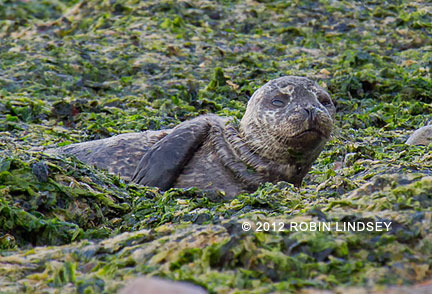
Tumbler’s health is still being carefully observed. He returned to the Sound just as darkness fell, so had at least 10 hours rest today. We can’t thank the waterfront residents enough for being so respectful of the struggling pup’s presence on their beach - and our dedicated volunteers who have been out for hours in the wind and cold.
10/7 8:15pm PUPDATE
No sign of Tumbler today. If you spot him, whether on public or private beach, please call our hotline @ 206-905-7325 (SEAL). He has some health issues and we’d like to keep an eye on him.
Seal pup Tumbler finds a quiet haulout
Oct/06/12 05:09 AM
Seal Sitters is happy to report that seal pup Tumbler, who spent a long day at Me Kwa Mooks beach on Tuesday, but wasn’t sighted the next day, has found a safe new resting spot. We had some health concerns and were hoping to be able to observe him over the following few days. Early Thursday afternoon, the hotline received a call about a pup on a private beach. Our responder found Tumbler sound asleep on the kelp-covered, pebbled beach.
Since the beach also had a public entrance so we closed that off with Protected Marine Mammal tape and stationed volunteers to keep an eye on him. And it’s a good thing we did - a neighbor’s offleash dogs ran out of the house and onto the beach about 20 feet away. Thankfully, the volunteer intercepted the dog and Tumbler continued to snooze. He was looking thinner than the other day, but has been coming and going from the beach, which is a good sign that he is foraging for food. Yesterday, he returned to the same stretch of beach and neighbors, as well as Seal Sitters, have been keeping a watchful eye over him. After a long nap on a thick kelp mattress, Tumbler returned to the waters of Puget Sound at sunset. We expect him to return again today.
Since there are such limited options for rehab of a seal pup, we want to ensure that Tumbler gets the best chance possible to survive in the wild - and undisrupted rest is critical to this survival. If you are a waterfront owner, please call our hotline at 206-905-7325 (SEAL) if you have a marine mammal on your beach - even if there is not public access. We monitor the health of all of our animals and a pup’s health can take a sudden drastic turn for the worse.
It is curious that for the past two weeks there have been no pups on the Alki platforms, after months of constant use by 5 or more pups. Is it coincidence or harassment by watercraft (fishing boats/kayaks/paddleboards) that has forced the pups to abandon them?
Since the beach also had a public entrance so we closed that off with Protected Marine Mammal tape and stationed volunteers to keep an eye on him. And it’s a good thing we did - a neighbor’s offleash dogs ran out of the house and onto the beach about 20 feet away. Thankfully, the volunteer intercepted the dog and Tumbler continued to snooze. He was looking thinner than the other day, but has been coming and going from the beach, which is a good sign that he is foraging for food. Yesterday, he returned to the same stretch of beach and neighbors, as well as Seal Sitters, have been keeping a watchful eye over him. After a long nap on a thick kelp mattress, Tumbler returned to the waters of Puget Sound at sunset. We expect him to return again today.
Since there are such limited options for rehab of a seal pup, we want to ensure that Tumbler gets the best chance possible to survive in the wild - and undisrupted rest is critical to this survival. If you are a waterfront owner, please call our hotline at 206-905-7325 (SEAL) if you have a marine mammal on your beach - even if there is not public access. We monitor the health of all of our animals and a pup’s health can take a sudden drastic turn for the worse.
It is curious that for the past two weeks there have been no pups on the Alki platforms, after months of constant use by 5 or more pups. Is it coincidence or harassment by watercraft (fishing boats/kayaks/paddleboards) that has forced the pups to abandon them?
Intense day for Seal Sitters as dangerous nets return
Oct/02/12 11:01 PM
Early this morning, a fisherman called NOAA’s Office for Law Enforcement, reporting two seals entangled in a tribal net in the Duwamish River. Officer Jay Dyer immediately called Seal Sitters’ hotline and informed us that the net was tied to a dock at Vigor Marine (these are tied to docks without Vigor’s permission). Our lead responders immediately mobilized into action, contacting the Harbor Island company to see if we could gain access across the property to get to the nets. At this point, we had no idea if the seals, said to be an adult and pup, were still alive or had already drowned.
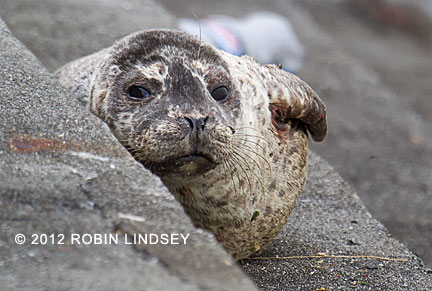 As our volunteers coordinated the task ahead of us, the hotline called again with a report of a seal pup at Me Kwa Mooks Park along West Seattle’s Beach Drive. Our responder found a pup lounging high up on the steps leading down to the beach. The dark pup had come up onto the steps at high tide, was alert and looked relatively plump compared to our recent emaciated pups. We taped off a large area so that the pup could get some rest. Volunteers were lined up in shifts to protect him throughout the day and our responders headed off to Harbor Island.
As our volunteers coordinated the task ahead of us, the hotline called again with a report of a seal pup at Me Kwa Mooks Park along West Seattle’s Beach Drive. Our responder found a pup lounging high up on the steps leading down to the beach. The dark pup had come up onto the steps at high tide, was alert and looked relatively plump compared to our recent emaciated pups. We taped off a large area so that the pup could get some rest. Volunteers were lined up in shifts to protect him throughout the day and our responders headed off to Harbor Island.
Assisted by Vigor Marine’s security officers, we scanned with binoculars the three nets that were strung across the river and tied to docks or shore on the company’s property. We could not find any entangled animals. However, this does not rule out that the seals drowned.
It is a very sad fact that each year seals, sea lions and seabirds perish in nets. Most often, it is seal pups that are victims of entrapment - adult seals learn to be much more savvy around the extremely dangerous nets. Each fall, nets are strung across Elliott Bay and the Duwamish River, while Seal Sitters awaits the dreaded call about an entanglement. Perhaps by some miracle these two seals were able to escape. Many thanks to Vigor for their assistance and allowing us access.
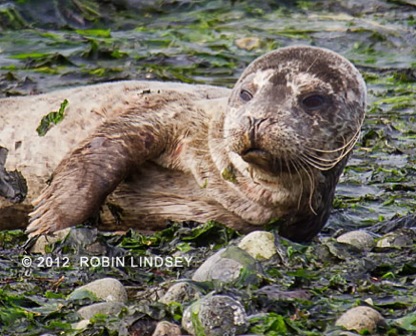 Our responders returned to West Seattle to spend the majority of the day observing the Me Kwa Mooks pup. He had a flipper wound but we could not determine if it was severe enough for concern. He did manage in the afternoon to quickly move down the steps and jump/tumble down the rather tall final step - hence, volunteers nicknamed him Tumbler. The pup spent the rest of the day enjoying the sun on the kelp-covered beach and swam off into the Sound about 4:30 pm as the tide came in. We will on the lookout for Tumbler and keep an eye on his/her health.
Our responders returned to West Seattle to spend the majority of the day observing the Me Kwa Mooks pup. He had a flipper wound but we could not determine if it was severe enough for concern. He did manage in the afternoon to quickly move down the steps and jump/tumble down the rather tall final step - hence, volunteers nicknamed him Tumbler. The pup spent the rest of the day enjoying the sun on the kelp-covered beach and swam off into the Sound about 4:30 pm as the tide came in. We will on the lookout for Tumbler and keep an eye on his/her health.
Thanks to hotline operator Gordon, schedulers Nancy and Nina and all the volunteers who kept Tumbler safe on this windy and often brisk day.

Assisted by Vigor Marine’s security officers, we scanned with binoculars the three nets that were strung across the river and tied to docks or shore on the company’s property. We could not find any entangled animals. However, this does not rule out that the seals drowned.
It is a very sad fact that each year seals, sea lions and seabirds perish in nets. Most often, it is seal pups that are victims of entrapment - adult seals learn to be much more savvy around the extremely dangerous nets. Each fall, nets are strung across Elliott Bay and the Duwamish River, while Seal Sitters awaits the dreaded call about an entanglement. Perhaps by some miracle these two seals were able to escape. Many thanks to Vigor for their assistance and allowing us access.

Thanks to hotline operator Gordon, schedulers Nancy and Nina and all the volunteers who kept Tumbler safe on this windy and often brisk day.







